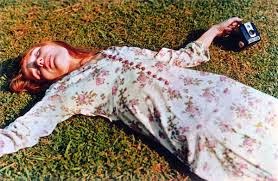Henri Cartier-Bresson
William Eggleston
Through the documentary that I had watched about William Eggleston i found out that he finds it hard to answer the question of 'What he photographs?' as there is no other answer than "life today". He believes in taking one picture at one time, this is because it stops you from getting confused over which picture is the most successful. He also leaves his images untitled as he feels like titles take the meaning away from photography. Also, he wants the viewer of the photo to discover their own interpretation of it without being influenced by the title.
Untitled by William Eggleston
William believes in not taking anything for granted in the sense of photographs, every tiny space counts. He treats everything that he witnesses equally symbolizing that all of his pictures of 'nothing' are worth something by declaring it a picture. His most notable work to date would have to be 'The Red Ceiling'. The work he produces is routed from his origins. He explained that he took this image out of the blue whilst talking with friends in bed, he randomly snapped up the image and they carried on talking. The function of all his photos are too evidence life as it is at that time. This is reflected through today's society as a lot of the population takes some form of image everyday using their smart phone or camera, it shows us how imagery has taken over our lives and how evidencing our lives is still used today without us even realising. Of which this image portrays this idea well due to the random composition of such a normal object that we use daily.
The quality of his work shows as he focuses on getting the image correct the first time as i have explained previously, it makes you concentrate on what you want to get out of an image and not what you could possibly achieve, bringing out motivation and thriving you to challenge imagery and art.
He progressed with his skills and love for art by being the first to bring colour into the art world through dye printing, which was used frequently within advertising, commercial and fashion photography. At this point in his life people were shocked and thought his images of colour were awful and did not appreciate them as the colour had showed what viewers already knew of. The function of the photographs were to document 'life' almost like a snapshot of time, representing a memory for somebody. The images work well as William Eggleston has used space within the photographs to balance out the bold colours. The composition of the photos work particularly well within these two images due to the central composition in the first image, the portrait automatically grabs your focus and the leading lines guide you across the image. Within the second image of the red car, the composition is at a diagonal to the puddle of water almost making a frame of which your direction of focus is guided to. His work also stands out for the interesting angles within both of these pictures, one being high, the other low, his innovative style means he stands out against other artists.
William Eggleston - unseen Kodachrome dye
transfer process photos.
These have been printed from the same group of 5,000 Kodachrome slides from which
Eggleston’s first exhibition in 1976 at the Museum of Modern Art were
taken and have been produced using dye transfer.
Whereas now colour is such a big part of photography and commercial advertising it comes naturally, you will see this though my own pictorial response as the colours within today's society are so vibrant and contrasting. It shows as time went on people have started to accept the impact of colour and how it is not only used in advertising but also day to day life. Therefore linking to the idea of my interpretation of 'life today'.
My Pictorial Response:
Personally I feel like my images do not reflect the style of William Eggleston, this could be because of the different era, time frame and geographical location used. As William lives in America and my images are within the UK, there is a clear difference between the physical appearance making my images associated more with architecture and cityscapes, whereas William has lived in Tennessee in a relaxed and rural location. Similarly fashions and styles have developed over the decades making the images appear different.
Bibliography
DVD: 'The Colourful Mr Eggleston' - https://www.youtube.com/watch?v=3jZ_HkaTXh8
http://www.telegraph.co.uk/culture/film/3647871/A-very-singular-vision.html











No comments:
Post a Comment